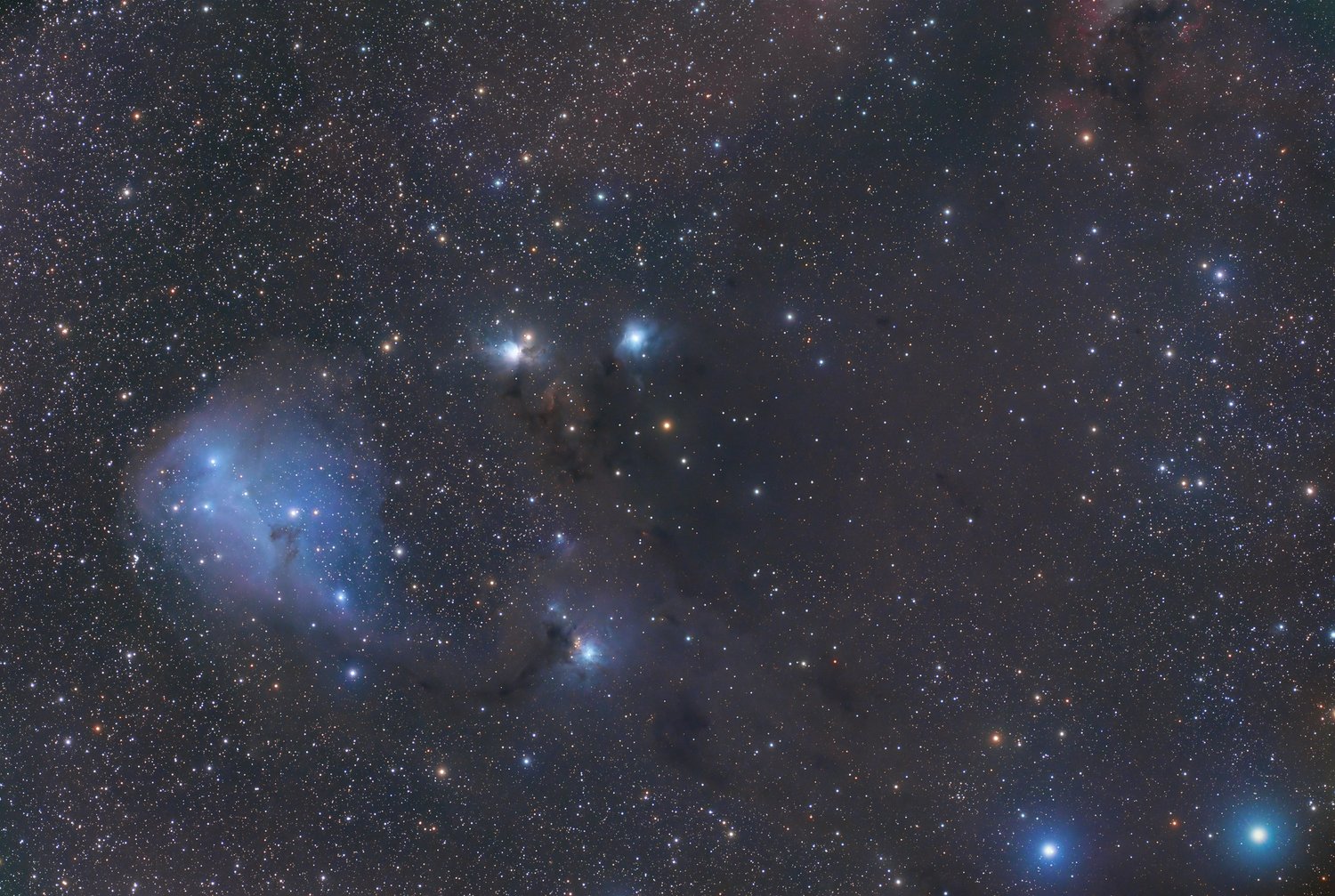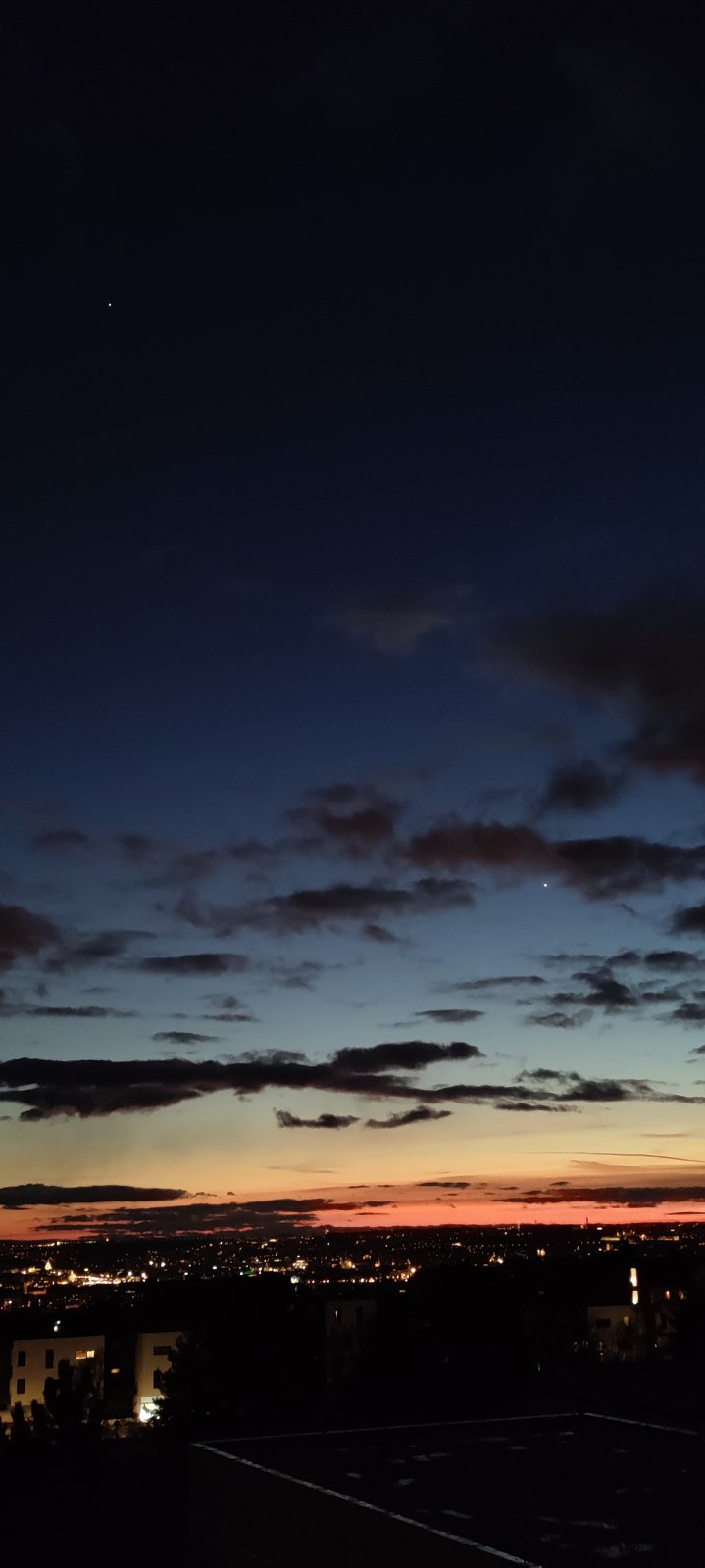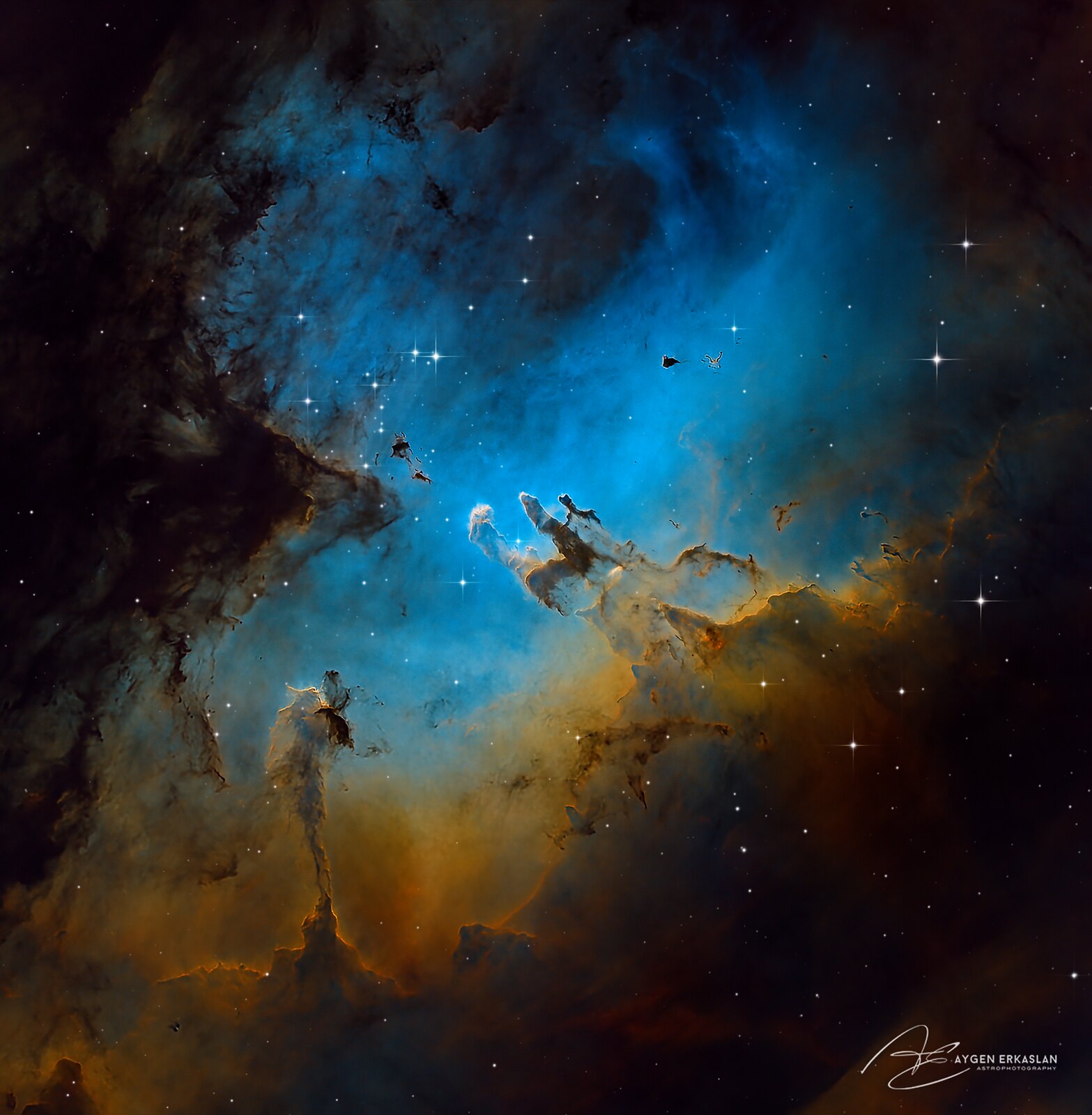Submissions: 2023 February
Submissions: 2023 February
__________________________________________________________________________________________________
Please post your images here.
Please see this thread before posting images; posting images demonstrates your agreement with
the possible uses for your image.
If hotlinking to an image, please ensure it is under 500K.
Hotlinks to images over 500K slow down the thread too much and will be disabled.
Thank you!
_________________________________________________________________________________________________
<- Previous submissions
Please post your images here.
Please see this thread before posting images; posting images demonstrates your agreement with
the possible uses for your image.
If hotlinking to an image, please ensure it is under 500K.
Hotlinks to images over 500K slow down the thread too much and will be disabled.
Thank you!
_________________________________________________________________________________________________
<- Previous submissions
Know the quiet place within your heart and touch the rainbow of possibility; be
alive to the gentle breeze of communication, and please stop being such a jerk. — Garrison Keillor
alive to the gentle breeze of communication, and please stop being such a jerk. — Garrison Keillor
Re: Submissions: 2023 February
Full size version : https://www.astrobin.com/m44gwm/G/
LDN 1622 - The Boogeyman in Orion
And here it is, the last rendering of the Dark Nebula LDN 1622 - also dubbed the Boogeyman.
The earliest version didn't really match my requirements. Hence this redux from scratch with overall better contrast, details, colors management.
Hope people will like it. I took a special care in the core to make sure that the dark nebula draw the attention needed.
Thank you and very best regards,
Aygen
Data credit : Aygen Erkaslan / ae_astrophotography
Date : lights gathered during the first three weeks of Jan 2023.
Location : own remote observatory, Spain
Scope : Takahashi TOA 130
Camera: ASI 6200 mm pro
LRGB_Ha :
Intégration time : 24H
LDN 1622 - The Boogeyman in Orion
And here it is, the last rendering of the Dark Nebula LDN 1622 - also dubbed the Boogeyman.
The earliest version didn't really match my requirements. Hence this redux from scratch with overall better contrast, details, colors management.
Hope people will like it. I took a special care in the core to make sure that the dark nebula draw the attention needed.
Thank you and very best regards,
Aygen
Data credit : Aygen Erkaslan / ae_astrophotography
Date : lights gathered during the first three weeks of Jan 2023.
Location : own remote observatory, Spain
Scope : Takahashi TOA 130
Camera: ASI 6200 mm pro
LRGB_Ha :
Intégration time : 24H
Milky Way in Cassiopeia and Cepheus
Milky Way in Cassiopeia and Cepheus
A 24°×35° wide-field view of the Milky Way in constellations Cassiopeia, Cepheus and the north-eastern part of Cygnus is presented in different color composites. This region is full of smaller emission nebulae. For many of them the ionization sources an thus the distance can be determined which provides an insight in the 3D structure of the milky way in that direction.
Click on the preview for detailed information and full resolution pictures (>100 MPixel).
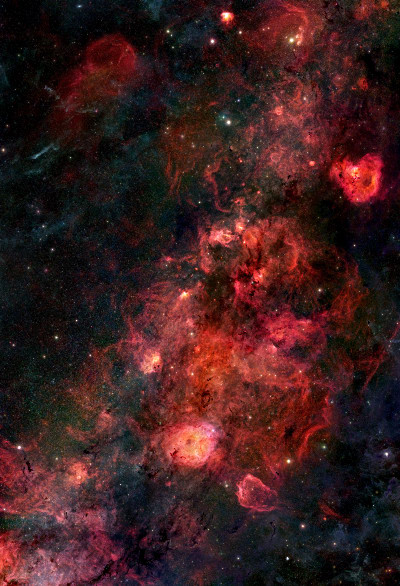
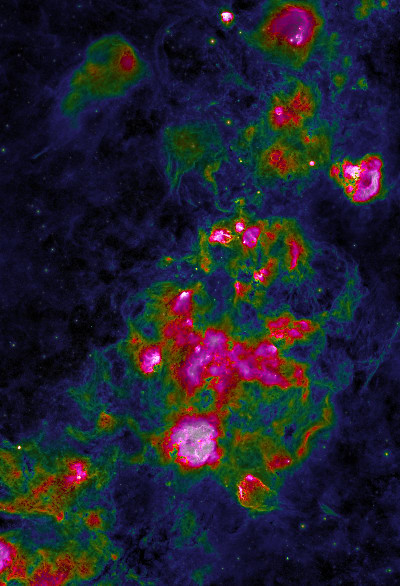
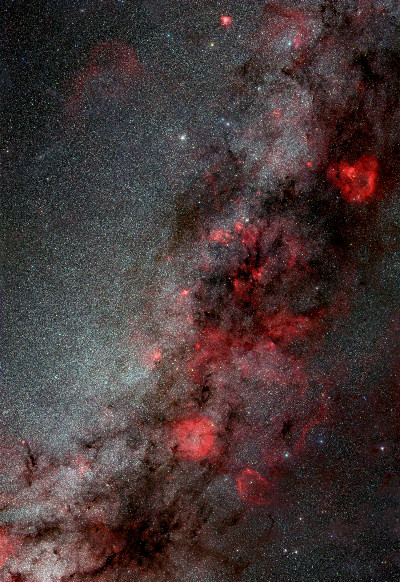
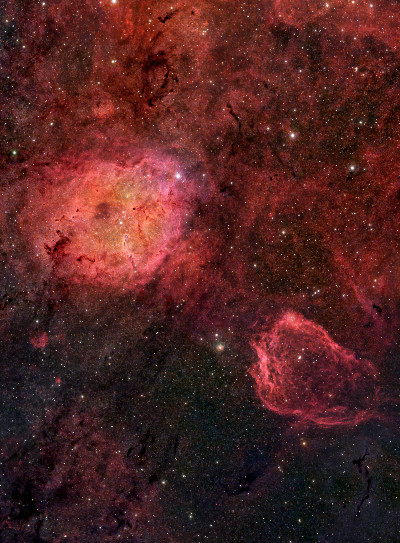
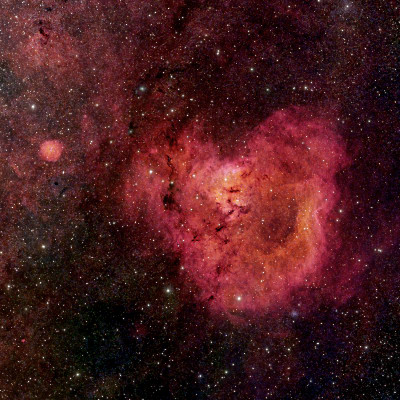
---
My Homepage
RSS news feed
A 24°×35° wide-field view of the Milky Way in constellations Cassiopeia, Cepheus and the north-eastern part of Cygnus is presented in different color composites. This region is full of smaller emission nebulae. For many of them the ionization sources an thus the distance can be determined which provides an insight in the 3D structure of the milky way in that direction.
Click on the preview for detailed information and full resolution pictures (>100 MPixel).





---
My Homepage
RSS news feed
Re: Submissions: 2023 February
Mars in cosmic dance among dark nebulae
I traveled 200 km to plan 2 nights of capturing this object and I came across this very bright "star", but the downside turned out to be an opportunity: Mars
Credit: Jaume Zapata
OTA: Samyang 135mm
Camera: ZWO ASI2600MC Pro
Total integration time: 13h 20'
I traveled 200 km to plan 2 nights of capturing this object and I came across this very bright "star", but the downside turned out to be an opportunity: Mars
Credit: Jaume Zapata
OTA: Samyang 135mm
Camera: ZWO ASI2600MC Pro
Total integration time: 13h 20'
-
stargazer1315
- Asternaut
- Posts: 8
- Joined: Wed Dec 07, 2022 10:51 pm
Re: Submissions: 2023 February
Comet C2022 E3 ZTF from the Egyptian desert, Valley of Whales
https://www.instagram.com/_stargazer13_/
Copyright: Mohammed Abdallah
This shot is taken from the Egyptian desert at the valley of whales, Fayoum City, bortle 2 on the night of the 26th of Jan
Settings
Nikon D3500
Sigma 24-70 at 60mm
Skywatcher SA Mini
about 30 minutes of data
sequator - Adobe PS - Siril
https://www.instagram.com/_stargazer13_/
Copyright: Mohammed Abdallah
This shot is taken from the Egyptian desert at the valley of whales, Fayoum City, bortle 2 on the night of the 26th of Jan
Settings
Nikon D3500
Sigma 24-70 at 60mm
Skywatcher SA Mini
about 30 minutes of data
sequator - Adobe PS - Siril
- Chris Peterson
- Abominable Snowman
- Posts: 18597
- Joined: Wed Jan 31, 2007 11:13 pm
- Location: Guffey, Colorado, USA
- Contact:
Re: Submissions: 2023 February
C/2022 E3
Imaged about 11 hours before its closest approach to Earth.
20x30s L, 20x60s R, 20x60s G, 20x60s B. Field width 21 arcmin. Captured with QSI660 camera on a 250 mm RC scope, tracking on the comet. Processed with PixInsight and Photoshop. Comet/starfield time = UT 2023-02-01 07:08.
_
Imaged about 11 hours before its closest approach to Earth.
20x30s L, 20x60s R, 20x60s G, 20x60s B. Field width 21 arcmin. Captured with QSI660 camera on a 250 mm RC scope, tracking on the comet. Processed with PixInsight and Photoshop. Comet/starfield time = UT 2023-02-01 07:08.
_
Chris
*****************************************
Chris L Peterson
Cloudbait Observatory
https://www.cloudbait.com
*****************************************
Chris L Peterson
Cloudbait Observatory
https://www.cloudbait.com
-
barretosmed
- Science Officer
- Posts: 482
- Joined: Thu Oct 12, 2017 6:04 pm
Re: Submissions: 2023 February
The Orion Nebula (left) and the Running Man Nebula (right)
BEST DETAILS
https://www.astrobin.com/full/jxps6q/0/
EQUIPMENT:
Espirit 150mm triplet
Zwo asi 6200mc
Mount CEM120
HDR COMPOSITION
168X300"
49 X 100"
77 X 50"
90 X 10"
LOCATION: Munhoz - MG - Brazil
DATES: 08/12/2022 to 09/19/2022
PROCESSING AND CAPTURE:
Adobe Lightroom Classic · Adobe Photoshop · Han K. Astrometric STAcking Program (ASTAP) · Main Sequence Software Sequence Generator Pro (SGP) · Open PHD Guiding Project PHD2 · Pavel Mráz SkytechX · Pleiades Astrophoto PixInsight
Author: Fernando Oliveira de Menezes
Email: Barretosmed@hotmail.com
(Organizing author of the book Amateur Astrophotography in Brazil)
https://clubedeautores.com.br/livro/ast ... -no-brasil
BEST DETAILS
https://www.astrobin.com/full/jxps6q/0/
EQUIPMENT:
Espirit 150mm triplet
Zwo asi 6200mc
Mount CEM120
HDR COMPOSITION
168X300"
49 X 100"
77 X 50"
90 X 10"
LOCATION: Munhoz - MG - Brazil
DATES: 08/12/2022 to 09/19/2022
PROCESSING AND CAPTURE:
Adobe Lightroom Classic · Adobe Photoshop · Han K. Astrometric STAcking Program (ASTAP) · Main Sequence Software Sequence Generator Pro (SGP) · Open PHD Guiding Project PHD2 · Pavel Mráz SkytechX · Pleiades Astrophoto PixInsight
Author: Fernando Oliveira de Menezes
Email: Barretosmed@hotmail.com
(Organizing author of the book Amateur Astrophotography in Brazil)
https://clubedeautores.com.br/livro/ast ... -no-brasil
-
Galactic-Hunter
- Ensign
- Posts: 26
- Joined: Wed Jul 08, 2020 3:13 pm
Re: Submissions: 2023 February
47 hours on Sh2-224 (also known as the Rice Hat Nebula).
This is a faint and difficult object to capture in Auriga. I shot this beautiful supernova remnant as bicolor (H + O) and am pleased with the results. The HA overwhelms the OIII when combined so it is important to be careful when bringing out the gases during processing. The processing overall was difficult but fun.
GEAR USED:
* Camera: QHY600M
* Telescope: SVX130
* Mount: GM1000HPS
* Guiding: ZWO ASI290Mini
* Processing: PixInsight
* ACQUISITION DETAILS:
* Total Exposure Time: 47 hours
* Exposure Time per frame: 600 seconds
* Filters: H + O 3nm
* Gain: 56
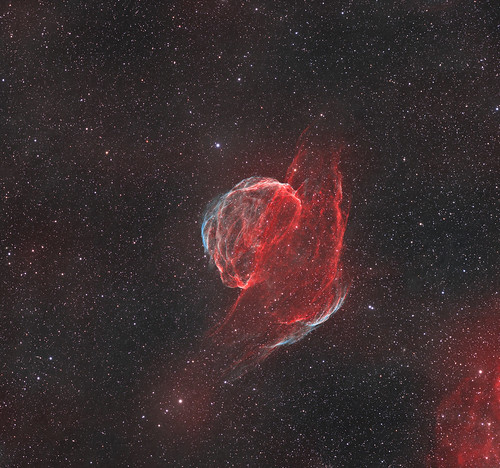 Sh2-224 - The Rice Hat Nebula
Sh2-224 - The Rice Hat Nebula
Credit:
Antoine Grelin
https://www.galactic-hunter.com/
This is a faint and difficult object to capture in Auriga. I shot this beautiful supernova remnant as bicolor (H + O) and am pleased with the results. The HA overwhelms the OIII when combined so it is important to be careful when bringing out the gases during processing. The processing overall was difficult but fun.
GEAR USED:
* Camera: QHY600M
* Telescope: SVX130
* Mount: GM1000HPS
* Guiding: ZWO ASI290Mini
* Processing: PixInsight
* ACQUISITION DETAILS:
* Total Exposure Time: 47 hours
* Exposure Time per frame: 600 seconds
* Filters: H + O 3nm
* Gain: 56
 Sh2-224 - The Rice Hat Nebula
Sh2-224 - The Rice Hat Nebula Credit:
Antoine Grelin
https://www.galactic-hunter.com/
-
Meiying Lee
- Ensign
- Posts: 66
- Joined: Sun Aug 15, 2021 8:28 am
Re: Submissions: 2023 February
Mock Mirage Sunspots and Green Flashes
Photo description:
At sunset on January 30, I recorded mock mirage sunset and green flashes on Mount Hehuan at an altitude of 3,000 meters. In the mock mirage sunset formed by multiple temperature inversion layers on the high mountain, the sun has various wonderful changes. Because sunspots are very active recently, obvious mock mirage sunspots have also formed! I judged the positions of at least 3 layers of inversion layers through the positions of 3 groups of mock mirage sunspots, which are marked by horizontal dotted lines in the figure. When the top of the sun falls into the inversion layer, it produces a very obvious green flash. The video link of mock mirage sunset is as follows:
In the film, you can see the sun changing layer by layer, and green flashes emerge from the top from time to time. Mock mirage sunspots are also forming at several locations. It is really an amazing mock mirage sunset!
Equipment Details:Canon R7 + 600mm Lens
Post-processing Details: Use PowerPoint to crop and enlarge the 6 photos and combine them together.
Location : Mount Hehuan, Nantou, Taiwan
Time: 5:42:10 PM to 5:45:51 PM
Photographer : Meiying Lee (李美英)
Photo description:
At sunset on January 30, I recorded mock mirage sunset and green flashes on Mount Hehuan at an altitude of 3,000 meters. In the mock mirage sunset formed by multiple temperature inversion layers on the high mountain, the sun has various wonderful changes. Because sunspots are very active recently, obvious mock mirage sunspots have also formed! I judged the positions of at least 3 layers of inversion layers through the positions of 3 groups of mock mirage sunspots, which are marked by horizontal dotted lines in the figure. When the top of the sun falls into the inversion layer, it produces a very obvious green flash. The video link of mock mirage sunset is as follows:
Click to play embedded YouTube video.
Equipment Details:Canon R7 + 600mm Lens
Post-processing Details: Use PowerPoint to crop and enlarge the 6 photos and combine them together.
Location : Mount Hehuan, Nantou, Taiwan
Time: 5:42:10 PM to 5:45:51 PM
Photographer : Meiying Lee (李美英)
Last edited by bystander on Thu Feb 02, 2023 5:29 pm, edited 1 time in total.
Reason: removed superfluous <img2> tags
Reason: removed superfluous <img2> tags
-
charleslillo@gmail.com
Re: Submissions: 2023 February
The M15 Globular Cluster (aka. Great Hercules Cluster)
https://www.theastrogeek.com/
Copyright: Charles Lillo https://images.squarespace-cdn.com/cont ... -tight.jpg
https://www.theastrogeek.com/
Copyright: Charles Lillo https://images.squarespace-cdn.com/cont ... -tight.jpg
-
charleslillo@gmail.com
Re: Submissions: 2023 February
IC 447, a reflection nebula located in the constellation Cassiopeia.
https://www.theastrogeek.com/
Copyright: Charles Lillo Full rez here
https://images.squarespace-cdn.com/cont ... /ic447.jpg
Robert Nemiroff (MTU) & Jerry Bonnell
https://www.theastrogeek.com/
Copyright: Charles Lillo Full rez here
https://images.squarespace-cdn.com/cont ... /ic447.jpg
Robert Nemiroff (MTU) & Jerry Bonnell
Re: Submissions: 2023 February
Comet C/2022 E3 (ZTF) - 25th of Jan
I managed to capture 2 hours of Comet ZTF on the night of the 25th of Jan as it was tearing near RR Ursae Minoris in Ursa Minor Constellation.
120×60″(2h)
 Green Comet (ZTW) - 25th of Jan by Ahmed Waddah, on Flickr
Green Comet (ZTW) - 25th of Jan by Ahmed Waddah, on Flickr
https://www.astrobin.com/1fp6vy/
Facebook: https://www.facebook.com/waddah.photography
Astrobin: https://www.astrobin.com/users/WolfHeart/
IG: https://www.instagram.com/waddahphotography/
I managed to capture 2 hours of Comet ZTF on the night of the 25th of Jan as it was tearing near RR Ursae Minoris in Ursa Minor Constellation.
120×60″(2h)
 Green Comet (ZTW) - 25th of Jan by Ahmed Waddah, on Flickr
Green Comet (ZTW) - 25th of Jan by Ahmed Waddah, on Flickrhttps://www.astrobin.com/1fp6vy/
Facebook: https://www.facebook.com/waddah.photography
Astrobin: https://www.astrobin.com/users/WolfHeart/
IG: https://www.instagram.com/waddahphotography/
-
Meiying Lee
- Ensign
- Posts: 66
- Joined: Sun Aug 15, 2021 8:28 am
Re: Submissions: 2023 February
Mock Mirage Sunspots
Photo description:
The mock mirage formed by the temperature inversion layer at sunset on the high mountain makes the sun look like layer upon layer of millefeuille. The original one sunspot has become a whole row of several sunspots! The real image of the sunspot is arranged together with its several virtual images, so it is difficult to judge whether it is true or false. Mock mirage sunspots are really amazing!
Mock mirage forming and disappearing video link: https://youtu.be/DSu6N3m6n8A
Equipment Details:Canon R7 + 600mm Lens
Post-processing Details: Use PowerPoint to crop and enlarge the 3 photos and combine them together.
Location : Mount Hehuan, Nantou, Taiwan
Time: 5:42:10 PM to 5:43:51 PM
Photographer : Meiying Lee (李美英)
Photo description:
The mock mirage formed by the temperature inversion layer at sunset on the high mountain makes the sun look like layer upon layer of millefeuille. The original one sunspot has become a whole row of several sunspots! The real image of the sunspot is arranged together with its several virtual images, so it is difficult to judge whether it is true or false. Mock mirage sunspots are really amazing!
Mock mirage forming and disappearing video link: https://youtu.be/DSu6N3m6n8A
Equipment Details:Canon R7 + 600mm Lens
Post-processing Details: Use PowerPoint to crop and enlarge the 3 photos and combine them together.
Location : Mount Hehuan, Nantou, Taiwan
Time: 5:42:10 PM to 5:43:51 PM
Photographer : Meiying Lee (李美英)
Last edited by bystander on Fri Feb 03, 2023 4:34 pm, edited 1 time in total.
Reason: removed superfluous <img2> tag
Reason: removed superfluous <img2> tag
Re: Submissions: 2023 February
 Chenonceau, the ISS and C/2022 E3 (ZTF) by Joel Klinger, sur Flickr
Chenonceau, the ISS and C/2022 E3 (ZTF) by Joel Klinger, sur Flickr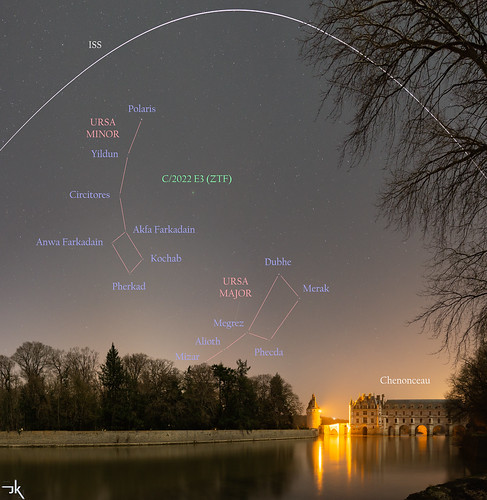 Chenonceau, the ISS and C/2022 E3 (ZTF) - Annotated by Joel Klinger, sur Flickr
Chenonceau, the ISS and C/2022 E3 (ZTF) - Annotated by Joel Klinger, sur FlickrLast Sunday, a unique configuration was visible in the sky of Chenonceau (France): the International Space Station was transiting above the castle lit by the half Moon, while the comet C/2022 E3 (ZTF) was traveling in the axis of the stars Dubhe/Merak (Ursa Major) and Polaris (Ursa Minor).
It has been a magical moment, even if the most important for me is not visible on the picture: my second son was with me that evening with his camera and his mini tripod, and for the first time he captured a transit of the ISS!
Date: 29th January 2023
Location: Castle of Chenonceau, France
Nikon D610 + Sigma France 35mm Art + Manfrotto 190XPROB / 494RC2
Panorama from 2 rows of 3 shots @ 24mm, 30s, f/4.5, ISO1600
-
Rafeee
- Ensign
- Posts: 51
- Joined: Fri Feb 24, 2012 8:52 pm
- Location: Hungary, Zselic Starry Sky Park
- Contact:
Re: Submissions: 2023 February
C/2022 E3 (ZTF) - Comet at infinity
Copyright: Rafael Schmall
https://www.astrobin.com/users/Rafeee/
Amateur astronomers have been obsessed with the comet for days. In Hungary, the weather was not favorable for observing the comet, but on the last two moonless days at dawn, we managed to photograph this wispy celestial wanderer.
In the image, the comet is the main subject: the elongated band to the left is the ion plume, while the comet's plume leaning to the right is the dust plume. What is really surprising, however, are the two galaxies to the upper left of the ion plume. Their distance is enormous... They are ~430 million light years away!!!
Image Details:
Equipment: ZWO ASI294MC-Pro, SkyWatcher EQ6PRo-Goto, SkyWatcher 200/800 Quattro, Stellarmate, ZWO ASI120MM
Exif data: 100x60sec, 40x120sec RGB, Gain 120, f4
Processing: SiriL, Photoshop
Location: Hungary, Zselic, R1 Observatory
Copyright: Rafael Schmall
https://www.astrobin.com/users/Rafeee/
Amateur astronomers have been obsessed with the comet for days. In Hungary, the weather was not favorable for observing the comet, but on the last two moonless days at dawn, we managed to photograph this wispy celestial wanderer.
In the image, the comet is the main subject: the elongated band to the left is the ion plume, while the comet's plume leaning to the right is the dust plume. What is really surprising, however, are the two galaxies to the upper left of the ion plume. Their distance is enormous... They are ~430 million light years away!!!
Image Details:
Equipment: ZWO ASI294MC-Pro, SkyWatcher EQ6PRo-Goto, SkyWatcher 200/800 Quattro, Stellarmate, ZWO ASI120MM
Exif data: 100x60sec, 40x120sec RGB, Gain 120, f4
Processing: SiriL, Photoshop
Location: Hungary, Zselic, R1 Observatory
-
EmanueleBalboni
- Ensign
- Posts: 16
- Joined: Sat Apr 25, 2015 4:03 pm
Re: Submissions: 2023 February
Mars with the two most famous open clusters in the sky: Iades and Pleiades!
Canon 6D astro mod
70 mm, f/3.5, 1600 ISO
Total integration time: 88 minutes
Mars, Pleiades and Iades
https://cosmoedintorni.org/
Copyright: Emanuele Balboni
Canon 6D astro mod
70 mm, f/3.5, 1600 ISO
Total integration time: 88 minutes
Mars, Pleiades and Iades
https://cosmoedintorni.org/
Copyright: Emanuele Balboni
-
Manel Martín Folch
- Ensign
- Posts: 15
- Joined: Tue Jan 10, 2017 7:13 pm
Re: Submissions: 2023 February
The beauty of comet C/2022 E3 ZTF
From the dark skies of the town of Ager in Lerida, I captured the comet C/2022 E3 ZTF, with a 530mm refractor. They were 15x80" exposures with LRGB filters.
Best regards.
https://www.astrobin.com/full/ciwfoq/D/
Manel Martín Folch
From the dark skies of the town of Ager in Lerida, I captured the comet C/2022 E3 ZTF, with a 530mm refractor. They were 15x80" exposures with LRGB filters.
Best regards.
https://www.astrobin.com/full/ciwfoq/D/
Manel Martín Folch
Re: Submissions: 2023 February
C/2022 E3 ZTF
After previous two attempts on Jan 20 and Jan 26 which came out nice, I wanted to capture some images on Feb 1 for obvious reasons. Moon and clouds gave me a break on Jan 31 for one hour around 4am. I was waiting several miles away from my house under Bortle 4 with my rig. It was a work weeknight too.
I could only get 1 hour of data before cloud rolled back in and then it was dawn.
Post processing was a big challenge. There were very strong star streaks in stacked comet image from DSS so I was forced to learn comet stacking in PI. Not much different result from PI as well. May be it was because I took 2min exposures and the comet was moving pretty fast. I then took a different route. I removed stars from all cometaligned images and cleaned them up by hand using clone stamp because both StarXterminator and StarNet+ left many stars in. Then I integrated those clean images, did usual noise reduction, stretching and some curves. After that I added stars from the star master light. Here is the result. I hope you will like it.
Skywatcher Esprit 100ed
ZWO AM5
ZWO ASI2600MCPRO
ZWO ASIAir Plus
ZWO EAF
ZWO OAGL
ZWO ASI290mm Mini
30x120"
Pixinsight
Bortle 4

After previous two attempts on Jan 20 and Jan 26 which came out nice, I wanted to capture some images on Feb 1 for obvious reasons. Moon and clouds gave me a break on Jan 31 for one hour around 4am. I was waiting several miles away from my house under Bortle 4 with my rig. It was a work weeknight too.
I could only get 1 hour of data before cloud rolled back in and then it was dawn.
Post processing was a big challenge. There were very strong star streaks in stacked comet image from DSS so I was forced to learn comet stacking in PI. Not much different result from PI as well. May be it was because I took 2min exposures and the comet was moving pretty fast. I then took a different route. I removed stars from all cometaligned images and cleaned them up by hand using clone stamp because both StarXterminator and StarNet+ left many stars in. Then I integrated those clean images, did usual noise reduction, stretching and some curves. After that I added stars from the star master light. Here is the result. I hope you will like it.
Skywatcher Esprit 100ed
ZWO AM5
ZWO ASI2600MCPRO
ZWO ASIAir Plus
ZWO EAF
ZWO OAGL
ZWO ASI290mm Mini
30x120"
Pixinsight
Bortle 4

-
martinkonrat
- Ensign
- Posts: 39
- Joined: Sun Sep 11, 2022 12:53 pm
Re: Submissions: 2023 February

Pencil Nebula and a portion of Vela Constellation. Wide Field.
The idea was to create a mixture of several hours of RGB data with the asi6200mc camera's built-in UV/IR filter and a few hours of narrowband data to enhance the thin lines of the O3 emission regions and highlight the Ha regions without losing the natural touch of the RGB data.
Dates: Jan. 25, 2023 · Jan. 27, 2023
Frames:
Antlia ALP-T Dual Band 5nm 2": 24×300″(2h)
ZWO UV IR CUT 2": 225×150″
Integration:11h 22′ 30″
Location: Giruá, RS, Brazil.
Telescope: Askar FRA300
Mount: ZWO AM5
Camera: ZWO Asi6200mc
Re: Submissions: 2023 February
Hey. Hey,
almost every night when the sky is clear, I can watch the sky show from my balcony. I live in Prague (Czech Republic), northern city part, overlooking the whole city to the southwest. In my picture, taken with mobile phone in hand, you can see Jupiter (top left), Venus (middle right) and some famous Prague buildings.
1) National Museum
2) Prague Castle
3) Petrin Tower
4) Church of St. Nicholas in Mala Strana (Lesser Town).
5) St. Vitus Church on Old Town Square
6) National Theatre
Picture was taken on February 4, 2023 at sunset at 17:49 CET.
Petr Vavra, Prague
Have a nice skyview!
almost every night when the sky is clear, I can watch the sky show from my balcony. I live in Prague (Czech Republic), northern city part, overlooking the whole city to the southwest. In my picture, taken with mobile phone in hand, you can see Jupiter (top left), Venus (middle right) and some famous Prague buildings.
1) National Museum
2) Prague Castle
3) Petrin Tower
4) Church of St. Nicholas in Mala Strana (Lesser Town).
5) St. Vitus Church on Old Town Square
6) National Theatre
Picture was taken on February 4, 2023 at sunset at 17:49 CET.
Petr Vavra, Prague
Have a nice skyview!
Re: Submissions: 2023 February
Full size: https://www.astrobin.com/zuymkl/
Hi there ! I am super thrilled to share with you my take on the very core of "Messier 16" - dubbed also the "Eagle Nebula".
Messier 16 is a region of active star formation, appearing in the constellation Serpens Cauda.
The Eagle Nebula lies some 7,000 light years away in the Sagittarius-Carina spiral arm of our galaxy - the next arm inward from us.
With regards to the final rendering, the color are applied my mixing three narrowband filters. The colors palette is commonly known as "the Hubble Palette".
I hope you will like it.
CS,
A.
Acquisition details :
Data credit: Aygen Erkaslan / Telescope Live
Date : 2023
Location : El Sauce, Chile
Scope : CDK 24" (F/6.8)
Camera : FLI PL 9000
Filters : SHO
Integration time : 16H
Hi there ! I am super thrilled to share with you my take on the very core of "Messier 16" - dubbed also the "Eagle Nebula".
Messier 16 is a region of active star formation, appearing in the constellation Serpens Cauda.
The Eagle Nebula lies some 7,000 light years away in the Sagittarius-Carina spiral arm of our galaxy - the next arm inward from us.
With regards to the final rendering, the color are applied my mixing three narrowband filters. The colors palette is commonly known as "the Hubble Palette".
I hope you will like it.
CS,
A.
Acquisition details :
Data credit: Aygen Erkaslan / Telescope Live
Date : 2023
Location : El Sauce, Chile
Scope : CDK 24" (F/6.8)
Camera : FLI PL 9000
Filters : SHO
Integration time : 16H
Re: Submissions: 2023 February
Hi,
A few new images foe 2023...
For full resolution and imaging details:
https://pbase.com/tango33/namibia_2022
Thanks,
Kfir Simon
Messier 17 mosaic: Messier 51: IC 4633: NGC 1360: Messier 65 & 66: Messier 66 alone: A starless Pelican: NGC 5033:
A few new images foe 2023...
For full resolution and imaging details:
https://pbase.com/tango33/namibia_2022
Thanks,
Kfir Simon
Messier 17 mosaic: Messier 51: IC 4633: NGC 1360: Messier 65 & 66: Messier 66 alone: A starless Pelican: NGC 5033:
-
Meiying Lee
- Ensign
- Posts: 66
- Joined: Sun Aug 15, 2021 8:28 am
Re: Submissions: 2023 February
The last 6 seconds of sunset
Photo description:
The last 6 seconds of sunset - the last yellow, green and blue lights line the horizon like pearls!
How does the sun disappear in the last few seconds of sunset? On the evening of January 31, I saw this wonderful sunset on Hehuan Mountain, which is 3,000 meters high. When the sun has fallen below the horizon, we can continue to see sunlight refracted from below the horizon because of atmospheric refraction. In the last few seconds, when there is only one line of sunlight left, because of the different refractive indices of various colors of light, we can see different colors of light—yellow, green, and blue are arranged on that line like pearls! In the last 1 second, they disappeared one by one in front of the camera. First, the yellow light with the smallest refractive index disappears, then the green light, and the blue light with the largest refractive index disappears last. Because the intensity of blue light is the weakest, and the eyes are more sensitive to yellow-green light, so the naked eye could only see a green light disappearing in the sky. What was left at the end was the cheers of everyone who saw the magical green light with their own eyes!
How the pearls of different colors disappear can be seen more clearly in the video. Video link: https://www.youtube.com/watch?v=RJ7vm4g5dXw
Equipment Details:Canon R7 + 600mm Lens
Post-processing Details: Use PowerPoint to crop and enlarge the 12 photos and combine them together.
Location : Mount Hehuan, Nantou, Taiwan
Time: 5:44:54 PM to 5:45:00 PM
Photographer : Meiying Lee (李美英)
Photo description:
The last 6 seconds of sunset - the last yellow, green and blue lights line the horizon like pearls!
How does the sun disappear in the last few seconds of sunset? On the evening of January 31, I saw this wonderful sunset on Hehuan Mountain, which is 3,000 meters high. When the sun has fallen below the horizon, we can continue to see sunlight refracted from below the horizon because of atmospheric refraction. In the last few seconds, when there is only one line of sunlight left, because of the different refractive indices of various colors of light, we can see different colors of light—yellow, green, and blue are arranged on that line like pearls! In the last 1 second, they disappeared one by one in front of the camera. First, the yellow light with the smallest refractive index disappears, then the green light, and the blue light with the largest refractive index disappears last. Because the intensity of blue light is the weakest, and the eyes are more sensitive to yellow-green light, so the naked eye could only see a green light disappearing in the sky. What was left at the end was the cheers of everyone who saw the magical green light with their own eyes!
How the pearls of different colors disappear can be seen more clearly in the video. Video link: https://www.youtube.com/watch?v=RJ7vm4g5dXw
Equipment Details:Canon R7 + 600mm Lens
Post-processing Details: Use PowerPoint to crop and enlarge the 12 photos and combine them together.
Location : Mount Hehuan, Nantou, Taiwan
Time: 5:44:54 PM to 5:45:00 PM
Photographer : Meiying Lee (李美英)
-
barretosmed
- Science Officer
- Posts: 482
- Joined: Thu Oct 12, 2017 6:04 pm
Re: Submissions: 2023 February
THE OPEN CLUSTER M46 AND THE PLANETARY NEBULA NGC 2438 AND PK231+4.1
The open star cluster M46, located in the constellation of Puppis, appears in the center of the image, where the planetary nebula NGC 2438 is still highlighted. In the upper left corner, we have the planetary nebula PK231+4.1. On the right side, maintaining its strong brightness, we have the star 140-Pup
BEST DETAILS
https://www.astrobin.com/full/7n0zx9/B/
EQUIPMENT:
Esprit 150mm triplet
Zwo asi 6200mc
Mount CEM120
Frames 109X100"
LOCATION: Munhoz - MG - Brazil
DATES: 12/17/2022 to 01/22/2023
PROCESSING AND CAPTURE:
Adobe Lightroom Classic Adobe Photoshop Han K. Astrometric STAcking Program (ASTAP) Main Sequence Software Sequence Generator Pro (SGP) Open PHD Guiding Project PHD2 Pavel Mráz SkytechX Pleiades Astrophoto PixInsight
Author: Fernando Oliveira de Menezes
Email: Barretosmed@hotmail.com
(Organizing author of the book Amateur Astrophotography in Brazil)
https://clubedeautores.com.br/livro/ast ... lCopyright: Your name
The open star cluster M46, located in the constellation of Puppis, appears in the center of the image, where the planetary nebula NGC 2438 is still highlighted. In the upper left corner, we have the planetary nebula PK231+4.1. On the right side, maintaining its strong brightness, we have the star 140-Pup
BEST DETAILS
https://www.astrobin.com/full/7n0zx9/B/
EQUIPMENT:
Esprit 150mm triplet
Zwo asi 6200mc
Mount CEM120
Frames 109X100"
LOCATION: Munhoz - MG - Brazil
DATES: 12/17/2022 to 01/22/2023
PROCESSING AND CAPTURE:
Adobe Lightroom Classic Adobe Photoshop Han K. Astrometric STAcking Program (ASTAP) Main Sequence Software Sequence Generator Pro (SGP) Open PHD Guiding Project PHD2 Pavel Mráz SkytechX Pleiades Astrophoto PixInsight
Author: Fernando Oliveira de Menezes
Email: Barretosmed@hotmail.com
(Organizing author of the book Amateur Astrophotography in Brazil)
https://clubedeautores.com.br/livro/ast ... lCopyright: Your name
-
Herbert_Walter
- Ensign
- Posts: 18
- Joined: Sat Nov 05, 2022 2:56 pm
Re: Submissions: 2023 February
IC 2177 - colorful head of the 'Seagull Nebula'
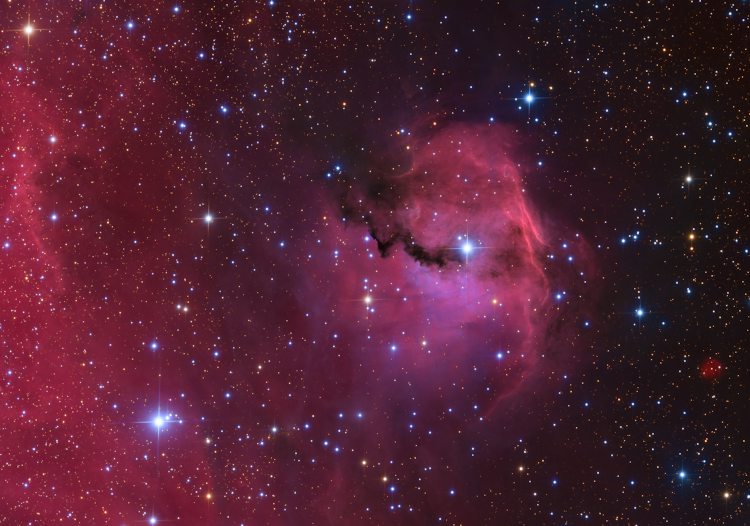
IC 2177 - head of the 'Seagull Nebula'. Such colorful nebula complexes
are among the most visually impressive objects in the night sky.
They are interstellar clouds of dust, molecules, hydrogen, helium and
other ionised gases where new stars are being born.
This object is listed not only in the IC catalog but also in others and known,
for example, as Sh 2-292, RCW 2, Gum 1, ...
More infos: https://www.skypixels.at/ic2177_info.html
IC 2177 - head of the 'Seagull Nebula'. Such colorful nebula complexes
are among the most visually impressive objects in the night sky.
They are interstellar clouds of dust, molecules, hydrogen, helium and
other ionised gases where new stars are being born.
This object is listed not only in the IC catalog but also in others and known,
for example, as Sh 2-292, RCW 2, Gum 1, ...
More infos: https://www.skypixels.at/ic2177_info.html


